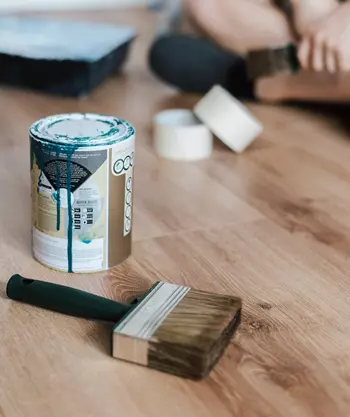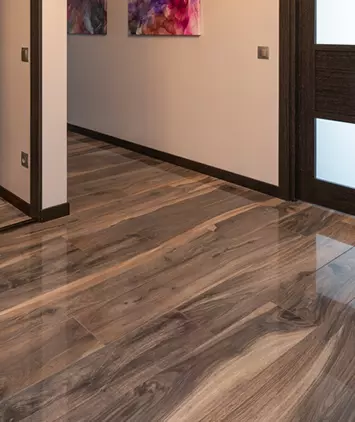When it comes to polyurethane, there are two main types available. So, what is the main difference between oil-based vs water-based polyurethane?
The main difference between oil-based polyurethane and water-based polyurethane is that oil-based polyurethane is made from natural oils, while water-based polyurethane is a synthetic polymer.
They both have their own benefits and disadvantages, and in this guide, we’ll go over the key points to help you decide which one is right for your project.
Water-Based Vs Oil Based Polyurethane

Polyurethane is a synthetic varnish that, when applied to wood, hardens into a durable and protective coating. It is typically used on projects such as floors, furniture, and trim.
Water-based polyurethane uses water to make the finish dry faster, so it’s ready to apply within eight hours.
While both products are similar in price, oil-based polyurethane is slightly more expensive and takes longer to apply.
However, it lasts longer and gives a high-gloss sheen with fewer coats. Oil-based polyurethane also enhances the natural color of woods like red oak and mahogany, giving them an amber glow.
Because of this property, oil-based polyurethane is often used on projects where the grain of the wood will be visible through the finish.
On the other hand, water-based polyurethane has less odor than oil-based finishes and dries quickly after application.
It also holds up well under traffic conditions, making it ideal for areas with high foot traffic like kitchens or bedrooms.
Water Vs Oil-based polyurethane for furniture
Polyurethane is a popular choice for finishing wood furniture because it is easy to apply, protects the wood surface well, and dries quickly.
If you’re refinishing a piece of furniture or applying a new finish to an old one, it’s important to understand the difference between water vs oil-based polyurethane for furniture.
Each has its own unique properties that make it better for particular types of projects.
How do you choose between these two?
The answer depends on the type of wood you’re working with, where the piece is going to live, and what look you want to achieve.
If it’s a softwood like pine or cedar, you’ll want to use water-based, because the added moisture can help prevent the wood from warping.
For hardwoods like oak or maple, oil-based is your best bet. It takes longer to dry, which means they soak into the surface of the wood deeply and completely.
Water-based Vs Oil-based Polyurethane For Cabinets
The choice between the two is a matter of personal preference. Both types have benefits in certain situations and drawbacks in others.
Understanding what sets them apart will help you make the decision about which one is best for your needs.
The first thing you’ll notice about a water-based poly for cabinets is that it has a milky white color, while an oil-based will be clear or amber in color.
This leads to a few other differences in appearance. The final color of the wood will be much lighter with the water-based product than with an oil-based one.
Oil or water-based poly For Table Top
Oil-based is recommended for tables made from raw or stained wood, as it protects better and highlights the natural color of the wood.
Because oil-based poly has a strong odor, you should use it in well-ventilated areas or outdoors.
Wearing a mask is a good idea when applying oil-based polys.
Water-based poly is recommended for tables made from painted or finished wood, as it brings out the color of the finish and does not yellow over time.
Water-Based Polyurethane Vs Oil Based For Floors
Again, they both offer high durability, but the most preferred option for floors is water-based polyurethane.
The main difference between the two is that water-based polyurethane is polymerized with water rather than mineral spirits/petroleum distillates.
This gives it several distinct advantages:
- It’s safer for humans and animals to be around (no toxic fumes).
- It doesn’t yellow as much as oil-based polyurethane does over time.
- It dries faster, so you can apply multiple coats on the same day (most oil-based polyurethanes require 24 hours between coats).
- It cleans up easily with soap and water.
Water-Based Vs Oil-Based Poly Stain
Water-based and oil-based stains both have a lot to offer homeowners, but they differ in some important ways.
Water-based stain is generally more popular because it dries faster and doesn’t produce harsh fumes, but oil-based stain penetrates deeper into the wood and often provides better protection against water damage.
Water-based stains dry quickly, are easier to clean up, don’t have the odor that oil-based stains have, and offer better color control.
However, they aren’t quite as durable as oil-based stains, and you can’t use them on top of an oil-based stain.
Oil-based stains need more time to dry and are more difficult to clean up. They also need more ventilation due to the strong odor.
On the other hand, it is more durable and does a better job of highlighting the grain in the wood.
Which one should you choose?
Both oil-based and water-based polyurethane has their pros and cons.
To choose the right one for your project, you need to consider what your objectives are going to be with the finished workpiece.
For example, if you want a natural look on your floors that will last for many years, then you may want to go with an oil-based product since it gives off a natural amber.
Varathane Water-based Polyurethane Vs Oil-based
- Crystal Clear Satin
- Water-Based
- Quick Drying Time
- Rust-Oleum
- 250241
- Stain & Finish
- Rust-Oleum
- 250241
- Stain & Fin
When you’re looking to protect your woodwork, there are two options that tend to quickly dominate the conversation:
Varathane’s Water-based and Oil-based Polyurethane. The question is, which one is right for your project?
The answer depends on how you intend to use the final product.
Let’s run through some of the major differences between the two products to help you make a more informed decision.
Varathane water-based polyurethane and oil-based polyurethane are both dependable, long-lasting finishes that protect the wood from scratches, sunlight, and everyday wear.
The water-based also dries quickly in about three hours.
And it’s clear, so it can be used on any color of wood without affecting its appearance.
Oil-based polyurethane is thicker than water-based polyurethane, making it more durable in the long run.
It also has a longer drying time – around 16 hours, and an amber shade that brings out the color of the wood.
When to Use Water-Based Polyurethane
This one is recommended for use on kitchen cabinets, furniture, and floors.
If you plan on painting over the surface with water-based paint, you should use a water-based finish.
It is also a great choice for stained wood areas (fireplace mantels or trim work) that are highly visible or get touched often.
It’s less likely to show wear marks from dirt and fingerprints than oil-based polyurethane.
The biggest reason to consider using this type of finish is that it’s easier and safer to work with.
There are fewer fumes and no harsh chemicals to deal with, and cleanup is as easy as a quick spray of water.
Water-Based Polyurethane Pros and Cons
ADVANTAGES:
Clear finish: This makes it ideal for use with many different kinds of material, so you don’t have to stick to a certain color or style of finish.
Odorless: you can use it without worrying about overpowering smells, especially in confined spaces like offices and small apartments.
Cleaning: It makes it great for people who are new to working with polyurethane or who don’t have the time or patience to deal with the clean-up process.
DISADVANTAGES:
Coats required: Water-based polyurethane provides a more matte finish, but it requires more coats than other types of polyurethane.
Less durable: It is also less durable against scratches, and it is difficult to see where the product has been applied previously because the wet coat looks exactly like the dried coat.
When to Use Oil-Based Polyurethane

Oil-based polyurethane is a clear finish that can be applied to wood or concrete surfaces to protect and seal the surface.
It can be used in both interior and exterior applications, on floors and furniture as well as doors and trim.
but, it’s not recommended for use on cabinets, countertops, or other surfaces where it will come into contact with food.
Oil-based polyurethane can be applied over stain or paint, but it goes on milky white and dries to a yellowish tint.
It takes time for it to cure completely – between 24 and 48 hours. However, once it’s cured, it has a glossy finish that offers wear and water resistance.
Oil-based polyurethane should always be used in a well-ventilated area.
If you’re using it indoors, make sure you open windows and turn on fans to circulate fresh air.
It’s flammable, so keep all flames away from the work area when applying the finish.
Oil-Based Polyurethane Pros and Cons
ADVANTAGES:
Hardshell: It’ll protect your wood floors from scratches and stains. It also builds up quickly, so you can get a thicker coat in fewer layers.
Coats required: Since it requires fewer coats than other finish options, which means it is less time-consuming to apply.
Self-leveling: It means that you won’t need to put much work into making sure the finish is completely smooth.
DISADVANTAGES:
Curing time: Polyurethane takes more time to dry and cure, which can be a problem if you are trying to get multiple coats of poly applied in one day.
Smell: The smell of oil-based poly as it dries can be very sharp and unpleasant. This can make it difficult to work in the same area that you plan to live in until the product has dried and cured.
Cleaning: It makes it harder to clean up than other types of finishing products. You may want to consider using disposable gloves for your protection.
Sticky: It remains sticky until it has fully cured, which can take weeks. It will be very important to protect the finish from dust and debris so that your hard work doesn’t go to waste.
Difference Between Oil and Water-based Polyurethane
Polyurethane is a resin that is used as a building material.
It is also used as a coating on wood and metal, or as an adhesive in paints, glues, and adhesives.
Oil-based polyurethane can be applied by brush, roller, or spray. It has a better flow and finishes.
On the other hand, water-based is best applied by brush because it is more transparent.
It is odorless while the other one is fragrant (although the smell will dissipate after drying).
Water-based vs oil-based polyurethane durability
Oil-based polyurethane is more durable because it has a stronger bond than water-based poly. While it has a higher initial cost, it will last longer while maintaining its appeal.
Water-based polyurethane is more likely to fade over time.
Cost of Water Based vs Oil Based
The cost of water-based paints varies from brand to brand and product to product.
On average, however, you can expect to spend less on a gallon of water-based paint than you would for the same amount of oil-based paint.
Wood Color Change
Water-based stains are easier to apply, clean up, and recoat. They dry more quickly, and they don’t raise the grain of the wood.
Their downside is that they aren’t as color-saturated as oil-based stains and don’t penetrate as deeply into the wood.
Woods that are treated with an oil-based finish will not change color if they get wet.
However, woods that are treated with a water-based finish may turn black or grey when they come into contact with water.
Water-based polyurethane vs oil based – Cleaning
Oil-based polyurethane is a popular finish for hardwood floors that are exposed to water, but they can be difficult to clean.
Scrubbing with a soft bristle brush and a mixture of warm water and dish detergent should do the trick.
Water-based polyurethanes offer quick drying times and are easier to clean.
In fact, cleaning up after water-based polyurethanes is just like cleaning up after latex paint.
Water vs oil-based polyurethane – Application methods
Water-based polyurethane:
Spray: Takes the least amount of time, but requires the most skill. You will need to wear a mask while you spray.
Brush: This is the best way to apply water-based polyurethane. It is easy to do and it only requires a few supplies.
Oil-Based Polyurethane:
Brush: This is the easiest way to apply oil-based polyurethane because it is simple to do and only requires a few supplies.
The benefit of using a brush is that it allows you to apply your finish in thin coats, which will dry faster and help reduce brush marks from showing up on your surface.
Oil-based vs water-based polyurethane – Number of coats
When refinishing wood, you have a couple of options for the topcoat. When using a water-based poly, you will need more coats than you would when using an oil-based one.
This is because the water-based poly is thinner than the oil-based (you will typically only need one to two coats, but these can be applied more thickly).
Frequently Asked Questions
Can you use oil-based polyurethane over water-based polyurethane?
Yes, it is possible to use oil-based over water-based polyurethane. It will just take longer to dry.
Is water-based polyurethane any good?
Water-based polyurethane is not the best option for use when you want a very durable finish or if the furniture will see heavy or even moderate levels of use.
What is the downside of oil-based polyurethane?
The main downside of oil-based poly is it takes quite a lot of time to dry between coats.
What is the main disadvantage of using water-based polyurethane?
Water-based polyurethane is significantly less durable than oil-based polyurethane, so it wears faster.
How do I get a smooth finish with water-based polyurethane?
The best way to get a smooth finish with water-based polyurethane is by applying thin coats, but the problem with that method is that it requires more time.
Does oil-based polyurethane dry clear?
Yes, it does dry clear. It will darken the wood somewhat, but will not yellow it.
Conclusion
What is the difference between oil-based vs water-based polyurethane?” The short answer is that it has a lot to do with how you apply it and what kind of surface you’re working on.
Both types of polyurethane are waterproof and both can be used as sealers, but they differ in their properties.
Water-based polyurethane tends to run smoother than oil-based, which some people prefer for easier application. Oil-based, though, dries more quickly, which means it’s more likely to cure under pressure.
Both types can be thinned with water or solvent for a thinner film, although the thickness of the resulting film will be different depending on the type of solvent used.

